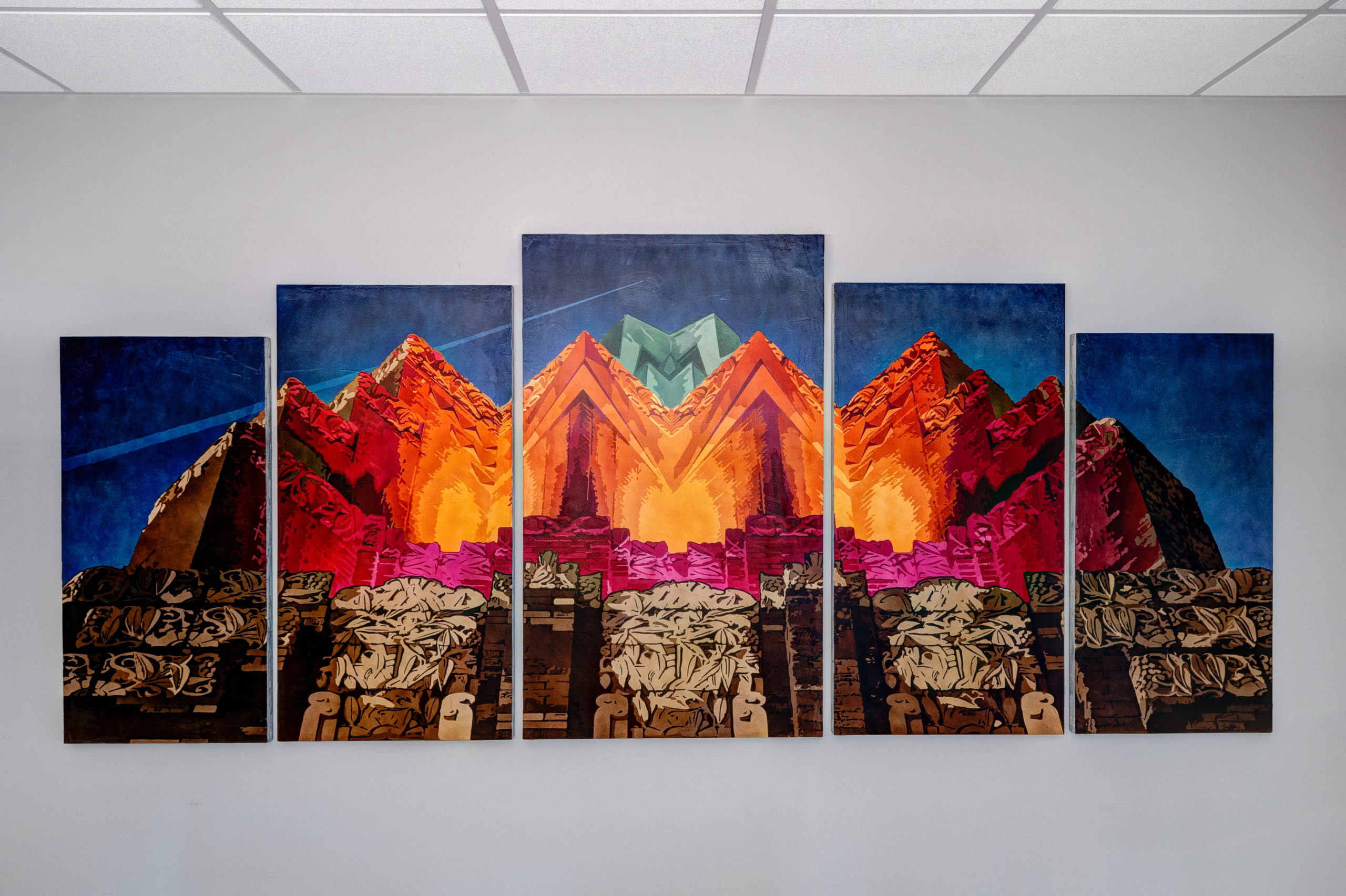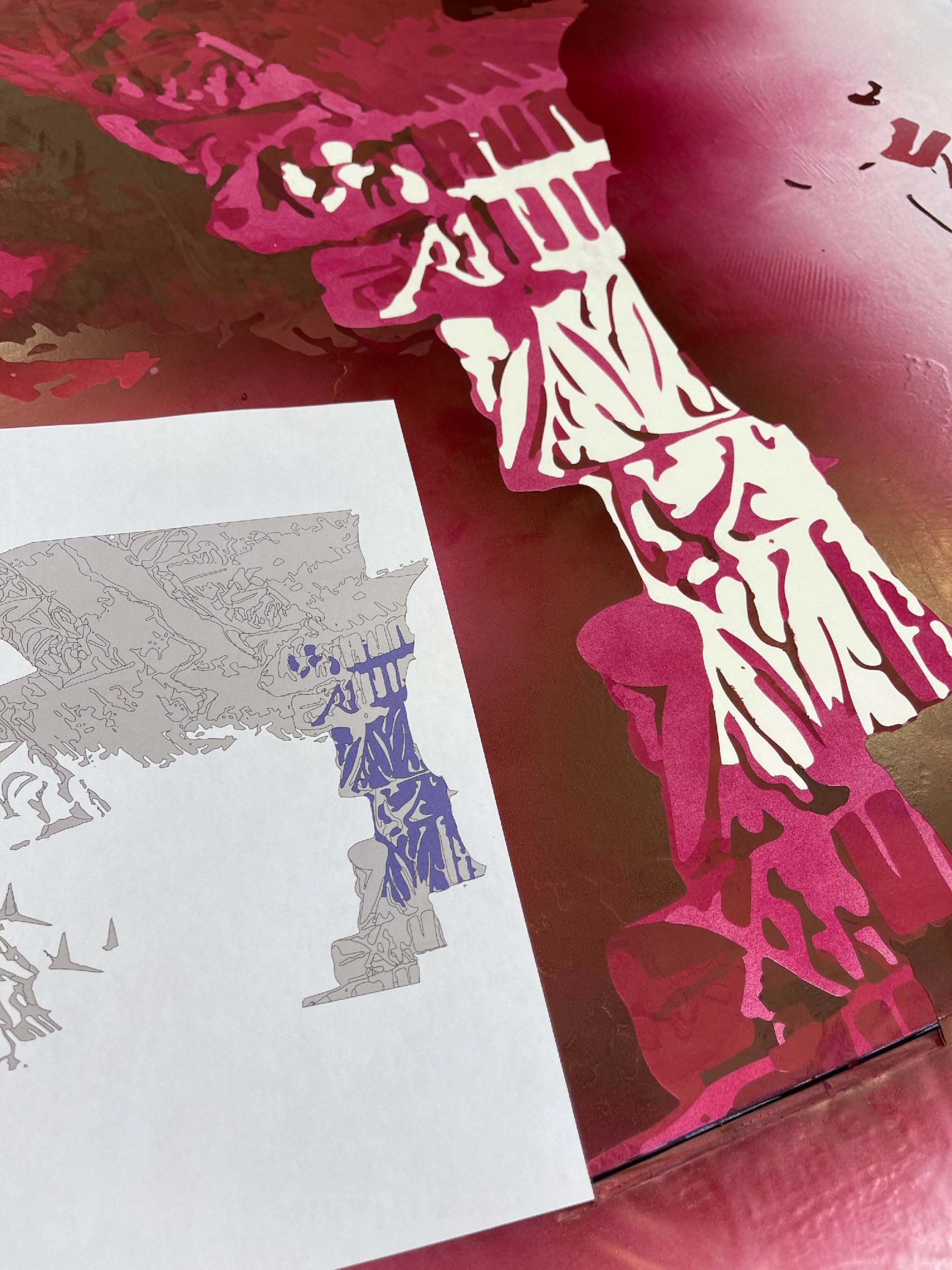
A depiction in lava-like hues of the Stiefel Theatre for the Performing Arts, greets Hutton team members and clients when they gather for meetings in the firm’s downtown Salina, Kansas office. A Wichita-based commercial architecture, construction and facility services firm, Hutton completed a reproduction of the theater spire in late 2020, and further enhanced the landmark by adding color spotlights after dark. It graces the revitalized Salina downtown, Artist Troy Vancil’s bold distortion suggests that he melted the face of the historic downtown structure, grabbed it with huge tongs and stretch it horizontally across five panels. “I think it’s awesome, a cool piece of art,” said Jason Gillig, northern Kansas team leader for Hutton. The project completes — and-or continues — a number of legacies for the company that acquired Salina-based Busboom and Rauh construction firm from in 2019. Busboom built the original Fox-Watson Theatre in 1931, Gillig said, and Hutton melded into that rich community history by continuing the renovation of the ornate downtown anchor, (now the Stiefel Theatre) helping to ensure a solid future.

“Concrete hasn’t been explored to its full potential,” Vancil said. “I thought I knew everything there was about it. Now I realize how little I actually knew.”
“We were pretty excited to come back and rebuild the tower on something Busboom did originally,” he said. “When you look at (the panels) it does have a message.” The monotone base represents the past with the foundation laid by Busboom and Rauh nearly a century ago, Gillig said. “The new tower kind of represents the vibrant future,” he said. “It’s Hutton building on the shoulders of Busboom, and that same thing at the Stiefel, the old to the new, and the resurgence of downtown Salina. There’s just a whole lot of parallels there.” Adding to the legacy, Vancil and his crew did the polished floors in the Stiefel Theatre’s Watson Room. In a collaboration with two other artists, Vancil conceived a way to commemorate the major restoration, enabling Hutton team members to cherish the accomplishment. “It’s gorgeous, that whole building,” said Debbie Harbin Wagner, famous in these parts for her sunrises, having painted nearly one a day for the past 16 years. “Troy approached Hutton about doing this concrete piece for the wall. He asked me to come on board to come up with the design element,” she said. “We made it more of an abstract approach toward the theater.” Done in several shades of bold colors, complete with an aircraft contrail to honor Salina’s aviation history, Vancil pulled off the 125-pound piece he calls “Rise.” “It’s like the Phoenix, a rebirth,” he said. “The tower was lost, and now it’s reborn.” Gillig understands the name. “I kinda get that feeling,” he said, “something rising up.” Growing up in Salina, Vancil, 58, formed more than his share of sidewalks and driveways, and knows his way around a trowel and a float. In recent years, Troy perfected finished indoor and outdoor floors that glisten under artificial and natural light. His company, Boulder Polishing, has made its mark on numerous projects in Salina and elsewhere in Kansas. Now he aims to make concrete a mainstream artistic medium by taking the material to a higher level. “Concrete hasn’t been explored to its full potential,” Vancil said. “I thought I knew everything there was about it. Now I realize how little I actually knew.” A number of artists helped him see beyond just the functionality of the material, and inject some beauty into the stuff that makes roads, bridges, buildings, polished floors, retaining walls and benches. “They look at it from a different angle, and can push the envelope of creativity. It makes for a great collaboration,” Vancil said. “I want to find more artists and polished concrete contractors to partner with. I want to do more art projects. More artists would work with concrete if they knew what products are available and how flexible they are.” He is making a case of artistic expression, said Heather Ferrell, a friend and former director of the Salina Art Center, whose career has taken her from home base in Utah to Qatar in the Middle East and currently director of exhibitions at Burlington City Arts in Vermont. Concrete as a base for artistic endeavors has been around since the 1960s, Ferrell said. Limits are bulk and weight, she said, especially when it comes to shipping. “The big challenge with concrete is that it sometimes limits people’s creative expression. It’s heavy, and more for permanent public artwork,” Ferrell said. “I think materials kind of fluctuate in popularity, and what Troy is trying to propose is a new possibility.” A number of graduate art students are using concrete in small doses, she said, and is used by a number of contemporary architects. This form of concrete adds an aesthetic, creative value, Ferrell said, enhancing the material’s “structural” aspects. Bold colors in the Hutton piece have been available for only a few years, Vancil said. “I couldn’t have done that 10 years ago. That’s how quickly things have evolved.” Acid stains have been available on concrete for more than a century, said Shawn Wardall, a former general contractor in Lake Mills in southeastern Wisconsin. Customers were rather ho-hum to the idea until 1990 the interest came back. “We started getting more and more interest in decorative concrete,” Wardall said. “From 2000 to 2003, I watched my volume double each year. That’s how fast it was growing.” He decided in 2004 to devote all of his efforts to decorative concrete and give up contracting. “It allowed me time to do a lot more research, do networking, visit trade shows and the Internet, to get more exposure to more manufacturers who were developing new product.” Industry noticed the demand in the early part of the new century and began developing new dyes and water-based stains. “It allowed them to expand the color palates and give us a lot more colors to incorporate into things,” Wardall said. Like Vancil, he was introduced to concrete as a boy and has been a part of its growth for nearly half a century. Wardall was working for Chicago-based Jon-Don, a national polished concrete distribution company, when they met at a Jon-Don training class in the spring of 2015 in Denver. They discovered they speak the same language and share similar passions. “We are part of a trend of always pushing the envelope to try and figure out ways to do more (with concrete),” Wardall said. “I think it’s a maturing industry. I’ve seen a lot of contractors get into it. We keep innovating.” Other flooring makers — ceramic tile, luxury tile, and others — have taken notice. “They have come up with designs that will mimic concrete because of its popularity,” Wardall said. He played a role in a number of Vancil’s artistic endeavors, including the Stiefel piece, another at St. John’s Missionary Baptist church in Salina, and a high-end residential project near Manhattan, Kansas. Collaboration on the Hutton Stiefel project settled on a bold move, artist Wagner said. Instead of the “traditional architectural approach,” she said, “we decided to do a multi-panel piece. We decided five panels would be quite aesthetically pleasing to give us that span.” The colors for the panels came from several companies including Ameripolish, Prosoco, and New Look International, said Rachel Knigge Bruce, a former employee of Ameripolish, who now owns and operates Floor Maps, Inc.. “We manufactured vinyl stencils that made Troy’s project possible,” she said. “We worked with him and provided the photo to create a vector illustration. We have a system of breaking each individual color into layers, isolating one color at a time.” The process starts with thin layers of concrete, starting with a white one.

“There’s a lot of talented people out there,” Vancil said, “and by combining their talents through collaboration, we can move the needle.”
“Then we had a perfect surface to explore the stencil print-making process on these five panels,” Wagner said “A lot of exploring and learning went on. I’m not sure if anything like this has been done. It required a lot of discovery to see how far we could push the dyes in the project,” Wagner said. Vancil researched concrete dyes, and found a fuchsia to reach “a really hot pink color,” Wagner said, and that is one of the bold colors that sets this piece apart.We also used a newer micro sealer called Impact from Ultra Durable Technologies that allowed us to have a matte finish for our top coat sealer. With Vancil and Wardall pushing limits on the concrete side, and input from a growing list of artists, both men are eager to help the medium grow. “It’s hard to match the resiliency. There’s a real sustainability factor,” Wardall said. “I know of terrazzo floors that are 100 years old. There is no reason why a properly maintained floor would completely disintegrate. It’s also easy to restore.” Terrazzo is a composite of chips of marble, quartz, granite, glass or other materials, that are poured with a “cementitious” or “polymeric” binder, or a combination or both, according to Wikipedia. It’s cured, ground and polished, and used for floors and walls. And now, a piece of Vancil’s concrete art hangs in the Salina Hutton conference room, and other sites in north-central Kansas. “I feel like it’s very innovative. I’m very excited about this process,” Wagner said. The process represents a different approach to printing, said Bruce, Rogers, Ark. Floor Maps is known for putting school mascots, corporate logos and other images into concrete flooring. She was “really happy,” with the Hutton piece. “It turned out beautiful,” Bruce said. “It’s always the best part, pulling off the last layer to see the finished product. It’s very satisfying.” Vancil and Wardall are both intent to continue delving into the creative possibilities of concrete. “There’s a lot of talented people out there,” Vancil said, “and by combining their talents through collaboration, we can move the needle.”
SIDEBAR: Ties abound in downtown art, architecture
By TIM UNRUH
Connections are a big deal in Salina, the regional center of north-central Kansas, and one illustration of that is the Stiefel Theatre for the Performing Arts. Local concrete expert-turned-artisan, Troy Vancil, is known for polished concrete construction throughout the town and region, including the Stiefel. His maternal grandfather, Leo Costello, worked as a job superintendent for Busboom and Rauh, which built the Stiefel, originally known as the Fox-Watson Theatre. “He played cards quite a bit, every Saturday, with Earnest Miller, a homebuilder in Salina and other Kansas cities,” Vancil said. Busboom’s final president was Bob Miller (Earnest’s grandson) when Hutton bought the company in early 2019. Bob Miller, who worked 43 years full-time for Busboom, today is a project manager with Hutton. His father, Vance Miller, was superintendent of Salina High School in 1954. He later went to work at Busboom & Rauh, rising to serve as the company’s general manager and a stockholder. A third-generation builder, Troy got his start in concrete working for his father, Don Vancil, who worked on numerous construction projects. Troy’s grandfather, Leo Costello, was a superintendent on a number of local and north-central Kansas area projects. He played a major role in the building of the historic Salina Fire Station No. 1 in downtown Salina. Debbie Harbin Wagner, is the daughter of the late Bill Harbin, founder of Harbin Construction, another well-known and respected builder in Salina. “It’s interesting how all of this is woven together,” Troy Vancil said. “It adds to the story.”.
